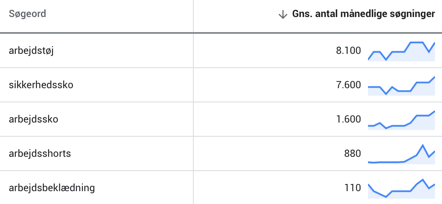The prerequisite for a successful new website is that the technical foundation of the website is in order - i.e. that there are no technical errors and inadequacies that impair the quality of the website and prevent Google from indexing the website. It is also a prerequisite that existing content from any old website is retained, expanded or optimized based on the target audience's search habits.
In this post, we describe a number of recommendations and considerations when developing a new website. The recommendations apply when developing a new website, regardless of the choice of CMS system (WordPress, Joomla, Shopify, etc.).
For a more in-depth guide, download a copy of Our migration book. Also consider downloading our SEO bookin which you get a more general guide to SEO.
Wireframes
Wireframes are graphical illustrations of the structure and content of a website that are created before the actual programming of the website begins. Typically, key stakeholders review the graphical wireframes to ensure that the requirements and goals of the new website are met through the design. It is also important that any wireframes are also reviewed from an SEO perspective.
It's easier and cheaper to make adjustments to the website during the design process rather than once the programming has started, and if you have to change a lot of programming afterwards, you risk shifting both the budget and the schedule for the entire migration. Therefore, the resources spent on reviewing and adjusting wireframes are well spent.
When reviewing wireframes from an SEO perspective, you need to pay particular attention to the amount of content there is room for on the pages. As a general rule, the amount of content on a page should be larger than the amount of content that competitors at the top of Google have on their corresponding pages. In practice, this means that a template - which is usually used on many different pages - must be able to accommodate a body text with a widely varying length depending on the individual page.
You can map the content of competitors' pages by performing a relevant Google search and manually counting the number of words on the top ranking pages. Alternatively, you can use a browser plugin such as SEOquake to automatically count the number of words.
When reviewing website wireframes, it is also important to ensure that the mobile version of the website does not contain less content than the desktop version. It is the mobile version that Google's indexing of the website is based on (so-called mobile-first indexing) and therefore the mobile version must not be a reduced version of the desktop version.
Indexing
While the new website is under development, it's important that search engines don't indexer the website. This is partly because strangers shouldn't be able to access the site while it's under development and partly because it can have major consequences for both the visibility of the existing site on Google and the visibility of the new site once it's launched. There are four ways to prevent search engines from indexing your website, the first of which is the one we recommend:
- IP restriction. Allow users with specific IP addresses (e.g. company IP address and selected home addresses) to access the website and block all other users from the website. Can usually be set up by the company's web or system administrator.
- Noindex tag. Insert a noindex tag () on all website pages. The tag tells search engines that the pages should not be indexed. The downside of this solution is that strangers can access the pages if they know the URL.
- Password protection. Set up password protection on the website. This is an effective access protection, but it has a significant drawback in that automated SEO tools typically cannot access the website, making it difficult to test the website.
- Robots-txt blocking. Block search engines from the website via the website's robots.txt file. The downside of this solution is that Google does not necessarily respect the blocking and at the same time, strangers can gain unhindered access to the website.
Page architecture
Page architecture is an expression of the website's menu structure and page structure. If the development of the new website is preceded by a keyword analysisThe page architecture should be determined based on considerations from the keyword analysis. This ensures that the website is built with relevant pages with relevant content that the target audience is searching for.
For example, suppose your website consists of a number of category pages, sub-category pages and product pages. If you don't know the search habits of your target audience, you'll create all these pages blindly without knowing if there is a demand for them - unless you have user data from your existing website that can tell you something about your audience's intentions and needs.
A concrete example is a webshop selling workwear. Here is a very brief keyword analysis using Google Keyword Planner:

The analysis shows that there is almost 80 times more demand for 'workwear' than 'workwear', making 'workwear' by far the best choice for a category page. The analysis also shows that there is a high demand for safety shoes, work shoes and work shorts, which can therefore benefit from each having their own category page on the website.
Internal links
Internal links are links on your website that link to other pages on the website. These links need to be updated during the migration to make sure they point to the correct pages on the new website. To update the links, you need to have an overview of all the pages on the new website and know their URLs.
Examples of internal links are:
- menu links
- text links in body text
- button links
- image links
We recommend that links are written with relative URLs (for example, '/specials/seo' instead of hhttps://inboundcph.dk/specialer/seo'). By making links independent of the domain, you can change the domain without having to correct the links afterwards. If you already use relative URLs and don't change the URLs of the pages during the migration, you probably don't need to update the internal links on the website.
Please note whether the URLs on the new website are written with or without a trailing slash (for example, 'inboundcph.dk/seo/' versus 'inboundcph.dk/seo'). Only one of the two versions can be used as the URL (and users must be automatically redirected from the wrong version to the correct version using a 301-redirect). If the URL in internal links is incorrect, users are redirected and the time it takes degrades the user experience.
Finally, a word of advice on internal links in body copy: The purpose of internal links is to guide users to other relevant pages and to help search engines understand the website's structure and most important pages. Therefore, it is an SEO advantage to link internally to the most important pages on the website that are also important for you to be visible on Google.
Content requirements
Content is crucial for a website's visibility on Google, so it's important that relevant content from the existing website is at least retained and, if possible, expanded and optimized based on a keyword analysis. Relevant content in this context is defined as content that has received a significant number of visitors from Google over a 12-month period. How high a number of visitors is significant is up to you to consider.
You can use Google Analytics to see which pages have received visitors from Google. Click 'Behavior' in the menu on the left and then 'Site content' and 'All pages'. If you only want to see visitors from Google (so-called organic traffic), you can add a segment at the top of the page - but remember that it's not just the number of visitors from Google that determines whether a page is retained.
It's important that you measure visitor numbers over a period of 12 full months. There may be relevant pages that only get traffic during certain periods - for example, Christmas-related pages - and you will lose that knowledge if you only look at traffic from the last month, for example. If you remove pages with visitor traffic, it goes without saying that you will lose that traffic on the new website.
The number of inbound links (i.e. links from other websites) to the pages on your website should also influence which pages you choose to keep. Inbound links are an essential part of SEO and one of the things Google weighs most heavily when determining positioning of a website. Therefore, you should avoid removing pages that have one or more inbound links.
You can view inbound links to your pages using a tool such as Ahrefs.com (commercial). However, a better solution is to use Screaming Frog (commercial) and via this set up an integration to Google Search Console and Ahrefs.com. This way you have data about both the sites, their visitor traffic from Google and inbound links all in one place.
While some content should be retained during a migration, it is rarely unavoidable that there is also a need to make significant changes to the existing content. These changes can include customizing content, moving content and deleting content. I the post about migration we provide more in-depth recommendations for these content changes.
Technical requirements
From a technical perspective, there are a number of areas your web developers need to consider when developing a new website. Many of these areas are relevant for all types of new developments - whether you're developing a completely new website or simply moving it from one domain to another - while others are only relevant in some cases. There are many areas, and it can be a lengthy process to get a handle on everything.
Among the areas are for example Redirects (redirects)that automatically redirects users from the old to the new website, a XML sitemapthat helps Google find all the pages on the new website, and a robots.txt file, which tells Google which parts of the new website it can index. It is important for redirects that all pages on the old website are mapped in a spreadsheet (for example, using Screaming Frog) before the site is taken down. The mapping will be used to later test if the redirects work.
The above areas and many others are described in our SEO book. Once again, it is important to point out that this is not a complete checklist for technical SEO, but an overview of areas that are essential for a migration. For example, SEO important areas such as hreflang and mobile-friendliness not included because they are not directly related to the migration of a website.
Data collection and data flow
Most websites collect statistics about their users through systems such as Google Tag Manager, Google Analytics, Adobe Analytics, Google Search Console, Leadfeeder, Facebook pixel and LinkedIn Insight Tag. These systems need to be set up on the new website so that data is not lost when the website is launched. If data is lost after migration, you also lose the ability to quickly evaluate and assess the impact of the migration.
It is also important that any conversion tracking in Google Analytics is set up on the new website. If you use third-party integrations (such as Zapier) to automatically collect data from the website and integrate this data with other systems, make sure these integrations are set up on the new website before the migration.
Testing the website
Before launching the website, the new website must be tested for technical errors and inconsistencies and these must be fixed before the migration takes place. As a minimum, the test should include the areas in the checklist below.
If you want to ensure that the new website meets all technical SEO requirements, you may want to conduct a more thorough technical analysis of the website based on the technical chapter in our SEO book. This extended analysis can touch on areas such as load time, mobile-friendliness, canonical tags, hreflang tags, page titles, response codes and structured data.
- Indexability. Check that all pages on the website can be indexed by Google, i.e. that they are not blocked via the website's robots.txt file or a noindex tag in the source code (any IP restriction must be removed immediately before migration). Recommended testing tool: Screaming Frog.
- Dead links. Check that there are no dead links on the website, i.e. there are no links that return a 4xx error code (page does not exist) or 5xx error code (server error). Recommended testing tool: Screaming Frog.
- Redirections. Check that all redirections is set up on the new website so that users are automatically redirected from the old to the new website. This check is manual until the migration has taken place.
- XML sitemap. Check that all pages on the new website are entered in the website's XML sitemapand that the sitemap is linked to in the website's robots.txt file. Recommended testing tool: Screaming Frog. Robots.txt is checked manually.
- Robots.txt. Check that robots.txt file on the new website does not block Google, including that Google is not blocked from indexing JavaScript, CSS and image files. This check is manual.
- Data collection. Check that tracking codes for analytics tools like Google Analytics, Adobe Analytics and Google Tag Manager are set up correctly on the new website and receiving data. This check is manual.















